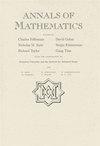Equiangular lines with a fixed angle
IF 5.7
1区 数学
Q1 MATHEMATICS
引用次数: 43
Abstract
Solving a longstanding problem on equiangular lines, we determine, for each given fixed angle and in all sufficiently large dimensions, the maximum number of lines pairwise separated by the given angle. Fix $0 < \alpha < 1$. Let $N_\alpha(d)$ denote the maximum number of lines in $\mathbb{R}^d$ with pairwise common angle $\arccos \alpha$. Let $k$ denote the minimum number (if it exists) of vertices of a graph whose adjacency matrix has spectral radius exactly $(1-\alpha)/(2\alpha)$. If $k < \infty$, then $N_\alpha(d) = \lfloor k(d-1)/(k-1) \rfloor$ for all sufficiently large $d$, and otherwise $N_\alpha(d) = d + o(d)$. In particular, $N_{1/(2k-1)}(d) = \lfloor k(d-1)/(k-1) \rfloor$ for every integer $k\geq 2$ and all sufficiently large $d$. A key ingredient is a new result in spectral graph theory: the adjacency matrix of a connected bounded degree graph has sublinear second eigenvalue multiplicity.具有固定角度的等角线
为了解决等角线上的一个长期问题,我们为每个给定的固定角度和所有足够大的维度确定了由给定角度成对分隔的线的最大数量。修复$0<\alpha<1$。设$N_\alpha(d)$表示$\mathbb{R}^d$中具有成对公共角度$\arccos\alpha$的最大行数。设$k$表示邻接矩阵的谱半径恰好为$(1-\alpha)/(2\alpha)$的图的顶点的最小数目(如果存在)。如果$k<\infty$,则对于所有足够大的$d$,$N_\alpha(d)=\lfloor k(d-1)/(k-1)\rfloor$,否则$N_\aalpha(d)=d+o(d)$。特别地,$N_{1/(2k-1)}(d)=\lfloor k(d-1)/(k-1)\lfloor$对于每个整数$k\geq2$并且都足够大$d$。一个关键因素是谱图论的一个新结果:连通有界度图的邻接矩阵具有次线性第二特征值多重性。
本文章由计算机程序翻译,如有差异,请以英文原文为准。
求助全文
约1分钟内获得全文
求助全文
来源期刊

Annals of Mathematics
数学-数学
CiteScore
9.10
自引率
2.00%
发文量
29
审稿时长
12 months
期刊介绍:
The Annals of Mathematics is published bimonthly by the Department of Mathematics at Princeton University with the cooperation of the Institute for Advanced Study. Founded in 1884 by Ormond Stone of the University of Virginia, the journal was transferred in 1899 to Harvard University, and in 1911 to Princeton University. Since 1933, the Annals has been edited jointly by Princeton University and the Institute for Advanced Study.
 求助内容:
求助内容: 应助结果提醒方式:
应助结果提醒方式:


